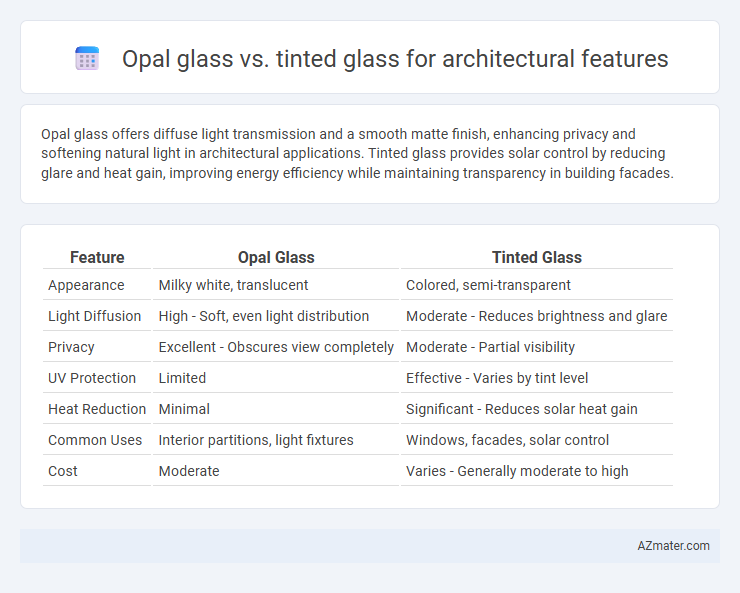Opal glass offers diffuse light transmission and a smooth matte finish, enhancing privacy and softening natural light in architectural applications. Tinted glass provides solar control by reducing glare and heat gain, improving energy efficiency while maintaining transparency in building facades.
Table of Comparison
| Feature | Opal Glass | Tinted Glass |
|---|---|---|
| Appearance | Milky white, translucent | Colored, semi-transparent |
| Light Diffusion | High - Soft, even light distribution | Moderate - Reduces brightness and glare |
| Privacy | Excellent - Obscures view completely | Moderate - Partial visibility |
| UV Protection | Limited | Effective - Varies by tint level |
| Heat Reduction | Minimal | Significant - Reduces solar heat gain |
| Common Uses | Interior partitions, light fixtures | Windows, facades, solar control |
| Cost | Moderate | Varies - Generally moderate to high |
Introduction to Opal Glass and Tinted Glass
Opal glass is a type of translucent glass known for its milky, diffused appearance that allows light to pass through while obscuring visibility, making it ideal for privacy and soft lighting effects in architectural features. Tinted glass contains additives that absorb sunlight and reduce glare, improving energy efficiency by minimizing solar heat gain while offering enhanced visual comfort in building facades. Both materials serve functional and aesthetic purposes in architecture, with opal glass emphasizing light diffusion and privacy, and tinted glass focusing on solar control and glare reduction.
Defining Opal Glass: Properties and Applications
Opal glass is characterized by its milky white, translucent appearance, created through the inclusion of opacifiers during manufacturing, which diffuses light evenly and reduces glare. Its properties include excellent light diffusion, high durability, and resistance to heat and chemicals, making it ideal for architectural features such as partitions, skylights, and facades that require privacy without sacrificing natural light. Common applications of opal glass focus on creating soft, ambient lighting effects and enhancing aesthetic appeal while providing functional benefits in interior and exterior design.
Tinted Glass Overview: Composition and Uses
Tinted glass, composed of standard glass infused with metal oxides such as iron, copper, or cobalt, offers reduced solar heat gain and enhanced glare control, making it ideal for energy-efficient architectural designs. Its applications include commercial facades, curtain walls, and window systems where controlling light transmission and improving privacy are essential. Compared to opal glass, tinted glass provides superior UV protection and is favored for modern buildings seeking both aesthetic appeal and functional solar performance.
Aesthetic Differences: Visual Impact in Architecture
Opal glass offers a soft, diffused light effect, creating a uniform and elegant glow that enhances interior spaces with a modern, minimalist aesthetic. Tinted glass provides varied color intensities and reflective properties, contributing to dynamic facades and controlling solar heat gain while adding depth and contrast to architectural designs. The choice between opal and tinted glass significantly influences the building's visual identity by balancing transparency, light diffusion, and color saturation.
Light Diffusion and Privacy Comparison
Opal glass offers superior light diffusion by scattering light evenly, creating a soft, glare-free illumination ideal for privacy-sensitive architectural features. Tinted glass reduces light transmission by absorbing a portion of sunlight, providing moderate privacy while maintaining some visibility and external views. For enhanced privacy and uniform lighting without compromising natural light quality, opal glass is preferred over tinted glass in architectural applications.
Energy Efficiency and Solar Control
Opal glass offers excellent diffusion of natural light, reducing glare while maintaining energy efficiency by minimizing the need for artificial lighting. Tinted glass enhances solar control by absorbing and reflecting a significant portion of solar radiation, effectively reducing heat gain and lowering cooling costs in buildings. Choosing between opal and tinted glass depends on balancing the desired light quality with solar heat management to optimize energy performance in architectural features.
Durability and Maintenance Requirements
Opal glass offers superior scratch resistance and is less prone to discoloration over time, making it highly durable for architectural features compared to tinted glass. Tinted glass requires more frequent cleaning to remove smudges and maintain clarity, while opal glass's matte surface better conceals fingerprints and dust. Maintenance for opal glass is generally lower, as it resists watermarks and staining better than tinted glass exposed to UV rays and harsh weather conditions.
Cost Analysis: Opal Glass vs Tinted Glass
Opal glass generally costs more than tinted glass due to its complex manufacturing process that involves embedding fine particles to diffuse light evenly for enhanced aesthetics and privacy. Tinted glass offers a more affordable option by simply adding colorants that reduce solar heat gain and glare, thus lowering energy expenses over time. Cost analysis favors tinted glass for budget-conscious projects, while opal glass demands higher upfront investment but provides superior light diffusion and design flexibility in architectural features.
Sustainability and Environmental Considerations
Opal glass enhances natural daylight diffusion, reducing reliance on artificial lighting and lowering energy consumption in buildings. Tinted glass minimizes solar heat gain, contributing to improved thermal comfort and decreased cooling loads, which supports energy efficiency. Both glass types play vital roles in sustainable architecture by optimizing light management and reducing carbon footprint.
Choosing the Right Glass for Architectural Features
Opal glass offers diffused light transmission with a smooth, opaque finish ideal for privacy and soft ambient lighting in architectural features. Tinted glass reduces solar heat gain and glare, enhancing energy efficiency and providing a sleek, modern aesthetic while maintaining partial visibility. Selecting between opal and tinted glass depends on the desired balance of light diffusion, privacy, thermal performance, and visual impact in the architectural design.

Infographic: Opal glass vs Tinted glass for Architectural feature
 azmater.com
azmater.com